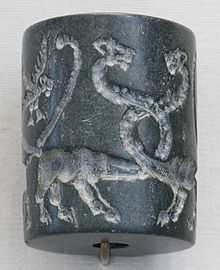Tell


A tell, or tel (from Hebrew: תֵּל,[1] Arabic: تَل, tall),[2] is a type of archaeological mound created by human occupation and abandonment of a geographical site over many centuries. A classic tell looks like a low, truncated cone with a flat top and sloping sides.[1] The term is mainly used of sites in the Middle East, where it often forms part of the local place name.
Archaeology

A tell is a hill created by many generations of people living and rebuilding on the same spot. Over time, the level rises, forming a mound.[3] The single biggest contributor to the mass of a tell are mud bricks, which disintegrate rapidly. Excavating a tell can reveal buried structures such as government or military buildings, religious shrines and homes, located at different depths depending on their date of use. They often overlap horizontally, vertically, or both. Archaeologists excavate tell sites to interpret architecture, purpose, and date of occupation. Since excavating a tell is a destructive process, physicists and geophysicists have developed non-destructive methods of mapping tell sites.[4]
List of tells
- Göbekli Tepe
- Gürcütepe
- Sultantepe
- Tall al-Ajjul
- Tall Jawa
- Tel Be'er Sheva
- Tel Bet Shean
- Tel Dan
- Tel Hazor
- Tel Lachish
- Tel Megiddo
- Tell Barri
- Tell Bazmusian
- Tell Beydar
- Tell Brak
- Tell Chuera
- Tell Leilan
- Tell Shemshara
- Citadel of Arbil
References
- ↑ 1.0 1.1 Archaeology of Palestine, Art of Excavating a Palestinian Mound, William Foxwell Albright, 1960, p. 16
- ↑ Kirkpatrick, E. M. (1983). Chambers 20th Century Dictionary (New ed.). Edinburgh: W & R Chambers Ltd. p. 1330. ISBN 0-550-10234-5.
- ↑ "Amateur Archaeologists Get the Dirt on the Past", New York Times
- ↑ Data analysis of tell sites
| |||||||||||||||||||||||||||||||||||||||||
